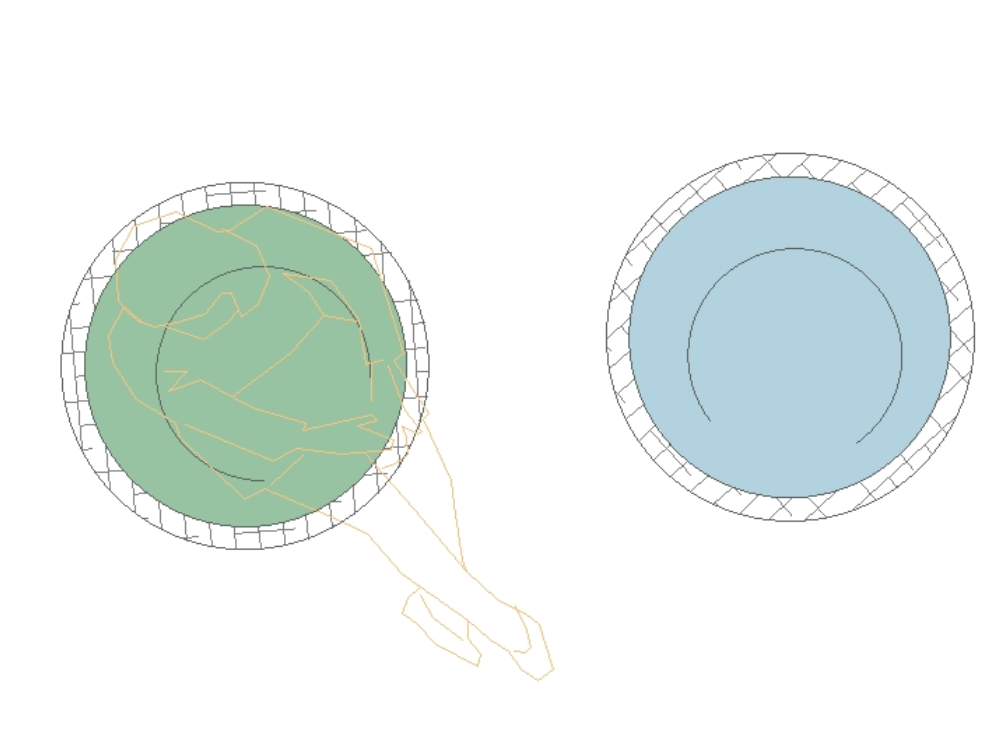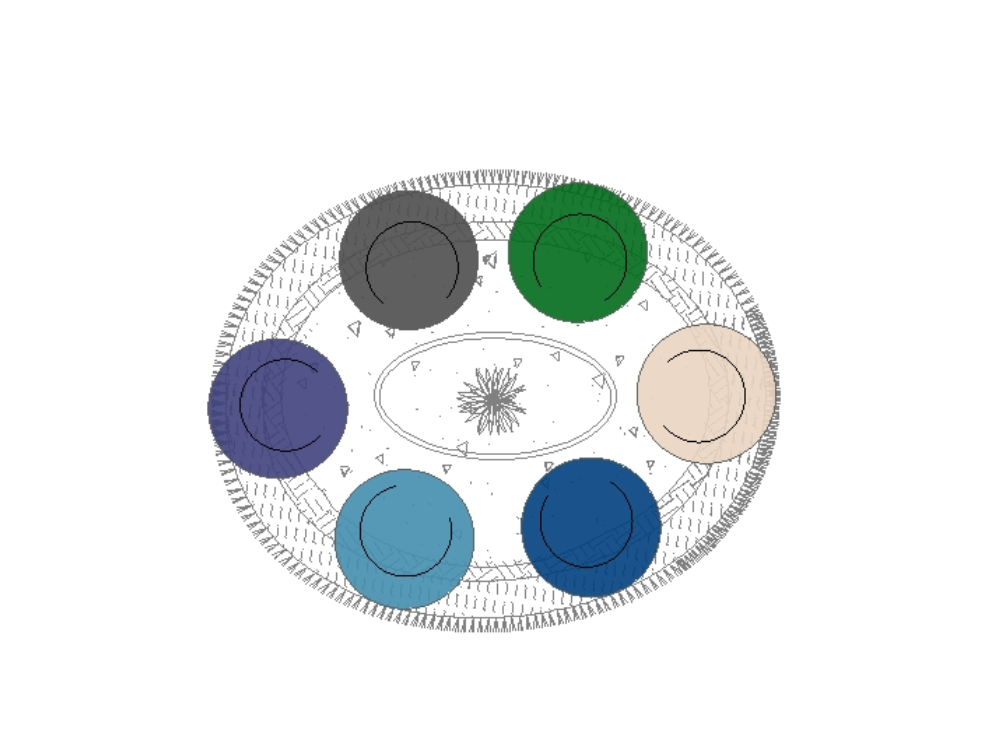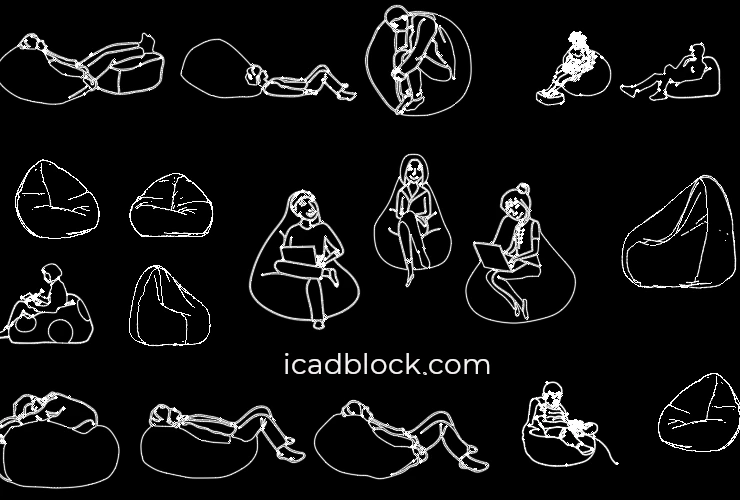Understanding Bean Bag Chairs and AutoCAD Blocks

Bean bag chairs, known for their comfort and versatility, have become a popular seating option in homes, offices, and public spaces. These chairs are characterized by their unique design and the use of soft, flexible materials that conform to the user’s body. Understanding the various types of bean bag chairs and their design features is essential for accurately representing them in design projects using AutoCAD blocks.
Types of Bean Bag Chairs
Bean bag chairs come in a wide range of styles and designs, each catering to different needs and aesthetics. Understanding these variations is crucial for selecting the appropriate model for your project.
- Traditional Bean Bag Chairs: These are the classic bean bag chairs, typically filled with polystyrene beads or other similar materials. They are known for their affordability and comfortable, “sink-in” feel. They often feature a simple, round or pear-shaped design.
- Modern Bean Bag Chairs: Modern bean bag chairs offer a more contemporary look, incorporating sleek lines and minimalist designs. They may feature unique shapes, bold colors, and high-quality fabrics. Some modern bean bag chairs even include built-in features like armrests or backrests.
- Luxury Bean Bag Chairs: Luxury bean bag chairs are designed for ultimate comfort and style. They often use premium materials, such as leather or high-quality fabrics, and feature advanced designs, such as adjustable backrests or built-in footrests. These chairs are typically more expensive than traditional or modern bean bag chairs.
- Outdoor Bean Bag Chairs: These bean bag chairs are specifically designed for outdoor use. They are made from weather-resistant materials and feature features like water-repellent fabrics and UV-resistant coatings. They are perfect for creating a comfortable and stylish seating area in gardens, patios, or balconies.
Benefits of Using AutoCAD Blocks for Representing Furniture
AutoCAD blocks are a powerful tool for efficiently representing furniture in design projects. They offer several advantages over manually drawing each object individually.
- Efficiency and Time Saving: AutoCAD blocks allow you to create a single, reusable representation of a furniture object. This eliminates the need to redraw the object every time it is needed in a project, saving significant time and effort.
- Consistency and Accuracy: Blocks ensure that all instances of a particular furniture object are identical in size, shape, and design. This maintains consistency throughout the project and helps to avoid errors.
- Flexibility and Customization: Blocks can be easily scaled, rotated, and moved, allowing for flexibility in design layouts. They can also be customized with different colors, materials, and details to suit the specific needs of the project.
- Improved Collaboration: Blocks can be shared among different members of a design team, facilitating collaboration and ensuring consistency in the representation of furniture objects across the project.
Creating an AutoCAD Block
Creating an AutoCAD block involves a simple yet structured process. This ensures that the block is accurately defined and can be used effectively in your projects.
- Select the Objects: Begin by selecting the objects that you want to include in the block. This could be a single object, such as a bean bag chair, or a group of objects, such as a set of furniture.
- Create the Block Definition: Once you have selected the objects, use the “Block” command in AutoCAD to create a block definition. This involves assigning a name to the block and specifying its insertion point. The insertion point determines where the block will be placed in your drawings.
- Define Attributes (Optional): Attributes allow you to add data to your block, such as the name, model number, or material of the furniture object. These attributes can be used to generate reports or schedule lists for the project.
- Insert the Block: After creating the block definition, you can insert it into your drawing using the “Insert” command. You can specify the scale, rotation, and position of the block as you insert it.
- Edit the Block: You can easily edit the block definition at any time. This allows you to modify the shape, size, or other properties of the block without affecting its instances in your drawings.
Designing a Bean Bag Chair AutoCAD Block

Creating a bean bag chair block in AutoCAD involves a meticulous design process that incorporates realistic dimensions, material representation, and visual appeal. This process leverages the power of AutoCAD’s tools to produce a block that is both functional and visually engaging.
Defining Dimensions and Materials
The first step in designing a bean bag chair block is to establish its dimensions. This involves determining the overall size of the chair, including its height, width, and depth. The dimensions should be realistic and reflect the typical size of a bean bag chair. For example, a standard bean bag chair might have a diameter of 3 feet and a height of 2 feet.
Once the dimensions are defined, the next step is to choose the materials that will be used to represent the bean bag chair in the block. This is crucial for creating a realistic and visually appealing block. Common materials for bean bag chairs include fabric, foam, and beads. In AutoCAD, these materials can be represented using different colors, line types, and hatch patterns.
Utilizing AutoCAD Tools for Design
AutoCAD offers a wide range of tools that can be used to design a bean bag chair block. These tools include:
- Line command: This tool allows you to draw straight lines, which are essential for defining the basic shape of the bean bag chair.
- Arc command: This tool allows you to draw curved lines, which are useful for creating the rounded shape of the bean bag chair.
- Circle command: This tool allows you to draw circles, which can be used to represent the bean bag chair’s base or other circular features.
- Ellipse command: This tool allows you to draw ellipses, which can be used to create the bean bag chair’s shape or other elliptical features.
- Spline command: This tool allows you to draw smooth curves, which are useful for creating the bean bag chair’s shape.
- Trim command: This tool allows you to trim lines and curves to create the desired shape of the bean bag chair.
- Extend command: This tool allows you to extend lines and curves to create the desired shape of the bean bag chair.
- Offset command: This tool allows you to create parallel lines or curves, which can be used to represent the bean bag chair’s thickness or other features.
- Hatch command: This tool allows you to fill areas with patterns, which can be used to represent the bean bag chair’s material.
- Solid command: This tool allows you to create solid objects, which can be used to represent the bean bag chair’s form.
Employing Layers, Colors, and Line Types
To create a visually appealing bean bag chair block, it’s important to use layers, colors, and line types effectively. Layers allow you to organize different parts of the block, such as the fabric, foam, and beads. Colors can be used to differentiate between different materials or to create a visually interesting design. Line types can be used to represent different types of lines, such as visible lines, hidden lines, and center lines.
For example, you could create a layer for the bean bag chair’s fabric, another layer for the foam, and another layer for the beads. You could then assign different colors to each layer, such as red for the fabric, blue for the foam, and green for the beads. You could also use different line types to represent the different materials, such as solid lines for the fabric, dashed lines for the foam, and dotted lines for the beads.
Creating a Realistic Bean Bag Chair Block
By carefully selecting dimensions, materials, and AutoCAD tools, you can create a realistic bean bag chair block that accurately represents the chair’s form and function. The block can then be used in various AutoCAD drawings, such as floor plans, elevations, and 3D models.
Using the Bean Bag Chair Block in AutoCAD Projects

The bean bag chair block, once created, becomes a valuable asset in your AutoCAD library, ready to enhance your room layouts with comfort and style. You can effortlessly insert this block into various room designs, tailoring its appearance to match your specific project needs.
Inserting the Bean Bag Chair Block into Room Layouts
Inserting the bean bag chair block into your AutoCAD project is a straightforward process.
- Open the AutoCAD drawing where you want to place the bean bag chair.
- Navigate to the “Insert” tab and select “Block.”
- In the “Insert Block” dialog box, browse to the location where you saved your bean bag chair block.
- Select the block and click “Open.”
- Position the bean bag chair block in your room layout using your mouse. You can adjust the size and rotation of the block as needed.
- To insert multiple bean bag chairs, simply repeat the process.
Modifying the Bean Bag Chair Block to Suit Specific Design Requirements, Bean bag chair autocad block
The flexibility of AutoCAD blocks allows you to modify the bean bag chair block to suit your specific design requirements.
- Scaling: Adjust the size of the bean bag chair block to fit the scale of your project. You can achieve this by selecting the block and using the “Scale” command. For instance, if you are working on a 1:10 scale drawing, you might need to scale the block down to 10% of its original size.
- Rotation: Rotate the bean bag chair block to the desired orientation using the “Rotate” command. This allows you to place the chair at different angles, creating dynamic and visually appealing arrangements.
- Color: Change the color of the bean bag chair block to match the color scheme of your project. You can access the “Properties” palette by right-clicking the block and selecting “Properties.” Within the “Properties” palette, you can modify the “Color” attribute to match your design.
- Material: For advanced visualization, you can apply different materials to the bean bag chair block. This can be achieved by using the “Materials” palette, which allows you to choose from a wide range of pre-defined materials or create your own custom materials. This feature enables you to represent the texture and appearance of various bean bag chair fabrics, such as leather, suede, or fabric.
Organizing a Collection of Bean Bag Chair Blocks for Various Styles and Sizes
Creating a library of bean bag chair blocks for different styles and sizes allows you to have a variety of options readily available in your AutoCAD projects.
- Style: Design bean bag chair blocks that reflect various styles, such as modern, contemporary, minimalist, or traditional. This ensures that you have a diverse selection of chairs to choose from, enabling you to create room layouts that align with different design aesthetics.
- Size: Create bean bag chair blocks in different sizes to accommodate various spaces and needs. This allows you to select chairs that are suitable for individuals, couples, or groups. For example, you could create blocks for small, medium, and large bean bag chairs.
- Organization: Organize your bean bag chair blocks in a logical manner within your AutoCAD library. You can create folders to categorize your blocks by style, size, or any other relevant criteria. This ensures that you can easily locate the desired bean bag chair block when needed.
The bean bag chair autocad block, a digital representation of this iconic piece of furniture, allows designers to visualize its placement and dimensions within a space. But the bean bag’s potential goes beyond mere seating. Imagine a world where comfort and versatility converge, where the bean bag transcends its traditional form to become a bed, a haven of relaxation.
See how this transformation unfolds in the bean bag chair bed video , and you’ll understand why the bean bag chair autocad block is just the beginning of a design revolution.
The bean bag chair AutoCAD block, a digital representation of comfort and relaxation, can be used to bring a touch of whimsy to any virtual design. Imagine a world where every room can be furnished with the plush comfort of a fluffy bean bag chair , a symbol of casual luxury.
The bean bag chair AutoCAD block allows designers to bring this dream to life, seamlessly integrating the relaxed charm of this iconic furniture into any virtual space.
